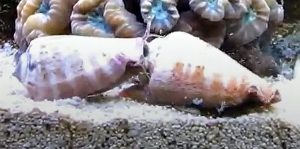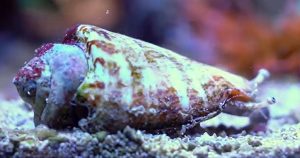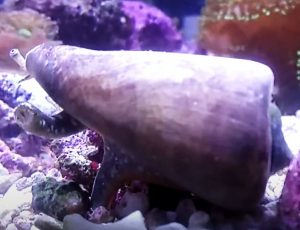The Tiger Conch (Conomurex luhanus) known to tropical fish keeping enthusiasts as the Strawberry Conch or Sand Tiger Conch is found throughout tropical Indo Pacific waters; like the Great Barrier Reef and southern reefs of Papua New Guinea.
The Tiger Conch is in the Strombidae family and is a true conch that is often found among corals in sandy, clay, and muddy substrates from the tidal zone, to as deep as 35 feet or more, where they graze on algae and detritus. They are most frequently found in shallow beaches just below the low tide line. As they mature, they move into deeper water and only return to relatively shallow waters, where quality food sources are more abundant, to deposit their eggs.
Juvenile Conomurex luhanus are often found in large colonies of the same size or class, that remain together for long periods. Mixed age colonies of Tiger Conch that are still separated by age and class within the colony also form up in the same areas for long periods, but remain separate from juvenile colonies.
The external color of the Tiger Conch can be white with an orange, brown to tan pattern of blotches, or completely brownish white. The shell interior is usually a rich orange, red or pink color, with a black or chocolate brown inner lip border. The shell interior may also be slightly grooved with fine thread like lines (lirated).
Tiger Conch have a whorled, thick, heavy, spindle shaped shell that is sometimes covered with a horny periostracum. Because of the relatively unusual conoidal shape of its shell, and its deep, easily distinguished stromboid notch; the Tiger Conch is freuently mistaken for the cone snail.
Unlike other marine snails in the Strombus family that slowly crawl along the sandy bottom, Tiger Conch thrust themselves off the sea floor in a leaping motion with their modified foot to move around the sea floor and escape predators. Compared to other marine snails, Conomurex luhanus are considerably more evolved. They have complex eyes on sensory tentacles at the end of long, independently moving eye stalks that they use to detect predators and nearby food. When injured, the eye stalks can regenerate. They sift their food from the substrate using a thick, trunk like proboscis
Like the Fighting Conch (Strombus pugilis), the Tiger Conch is best housed alone in a mature FOWLR or reef aquarium of at least 30 gallon capacity with plenty of deep sandy substrate for them to sift through and feed among. They spend an inordinate amount of time cleaning and sifting the sand bed and will often disappear under the substrate for long periods of time; sometimes months. Their sand sifting will not harm beneficial sand micro fauna or disturb bacterial micro zones in the sand bed.
Male Tiger Conchs can be territorial towards other males of its own kind, especially when housed in a small aquarium, however, they are peaceful towards other tankmates.
Strawberry Conchs have great appetites and will quickly clean up algae, detritus, and leftover food in the bottom of the aquarium. When sufficient food is not present in the substrate, they tend to climb the sides of the tank and on live rock searching for food. Because of their appetite, only a single individual is recommended for a small 30 gallon tank.
Like other invertebrates, the Tiger Conch is sensitive to high levels of nitrate and cannot tolerate copper based medications.
Tiger Conch have been bred in an aquarium environment.
When ready to copulate, male Conomurex luhanus extend a spade like, brownish black penis on the right side of the foot. Large groups of males and females congregate in deeper water on the sea floor to compete for copulating opportunities. Fertilization is internal and when reedy to reproduce, the male mounts the female from behind and clings to her shell using his foot. Placing the anterior portion of his shell over her shell lip, he is then able to insert his spade like penis into the siphon notch of the female.
After fertilization has occurred, females lay a long, adhesive, tubular egg mass in the sand or attached to pebbles or rocks in the shallower waters of the reef. The continuous tubular egg mass is folded back and forth on itself into a compact, oblong mass that holds several thousand eggs, and often reaches a length of several feet.
The eggs hatch out in 4 to 6 days into free swimming veligers that drift among plankton in the ocean currents for several weeks before finally settling on the sea floor. Tiger Conch are a fast growing species, with some members in the Strombidae family growing from a minute larvae, to a quarter pound semi adult in as little as one year.
Conomurex luhanus are benthic omnivores that feed primarily on marine algae, detritus, and any organic matter found in the substrate. In an aquarium environment with plenty of deep sand as a substrate, they eat algae, detritus, and any leftover foods they can find on the bottom of the tank. Because of their huge appetites, they will quickly clean a tank of every bit of detritus and require additional supplemental feedings of small pieces of fresh fish, dried seaweed, omnivore pellets, and high quality frozen foods with vegetable and organic matter.
Tiger Conch (Conomurex luhanus) are popular with tropical fish keeping enthusiasts for reef and FOLR tanks to aerate the substrate and rid their tanks of excess algae, detritus, and uneaten foods.
They are seasonally available online from a variety of retail sources at reasonable prices at approximate purchase sizes: in Australia 1.5″ to 2.55″ $2.70 to $8.70; in the Philippines 2.14″ to 3″ $2.60 to $8.60.
Minimum Tank Size: 30 gallons
Aquarium Type: Established Reef or FOWLR
Care Level: Easy
Temperament: Peaceful
Aquarium Hardiness: Hardy
Water Conditions: 73-80°F, dKH 8 to 12, pH 8.1-8.4, sg 1.020-1.025
Max. Size: 3.1″
Color Form: Orange, White, Yellow/Orange
Diet: Omnivore
Compatibility: Reef Compatible
Origin: Indo Pacific, Great Barrier Reef, Papua New Guinea
Family: Strombidae
Lifespan: 4 years
Aquarist Experience Level: Beginner





One Response to “Tiger Conch (Conomurex luhanus)”
Trackbacks/Pingbacks
[…] the Tiger Conch, a single Fighting Conch is best housed alone in a mature FOLR or reef aquarium of at least 30 […]